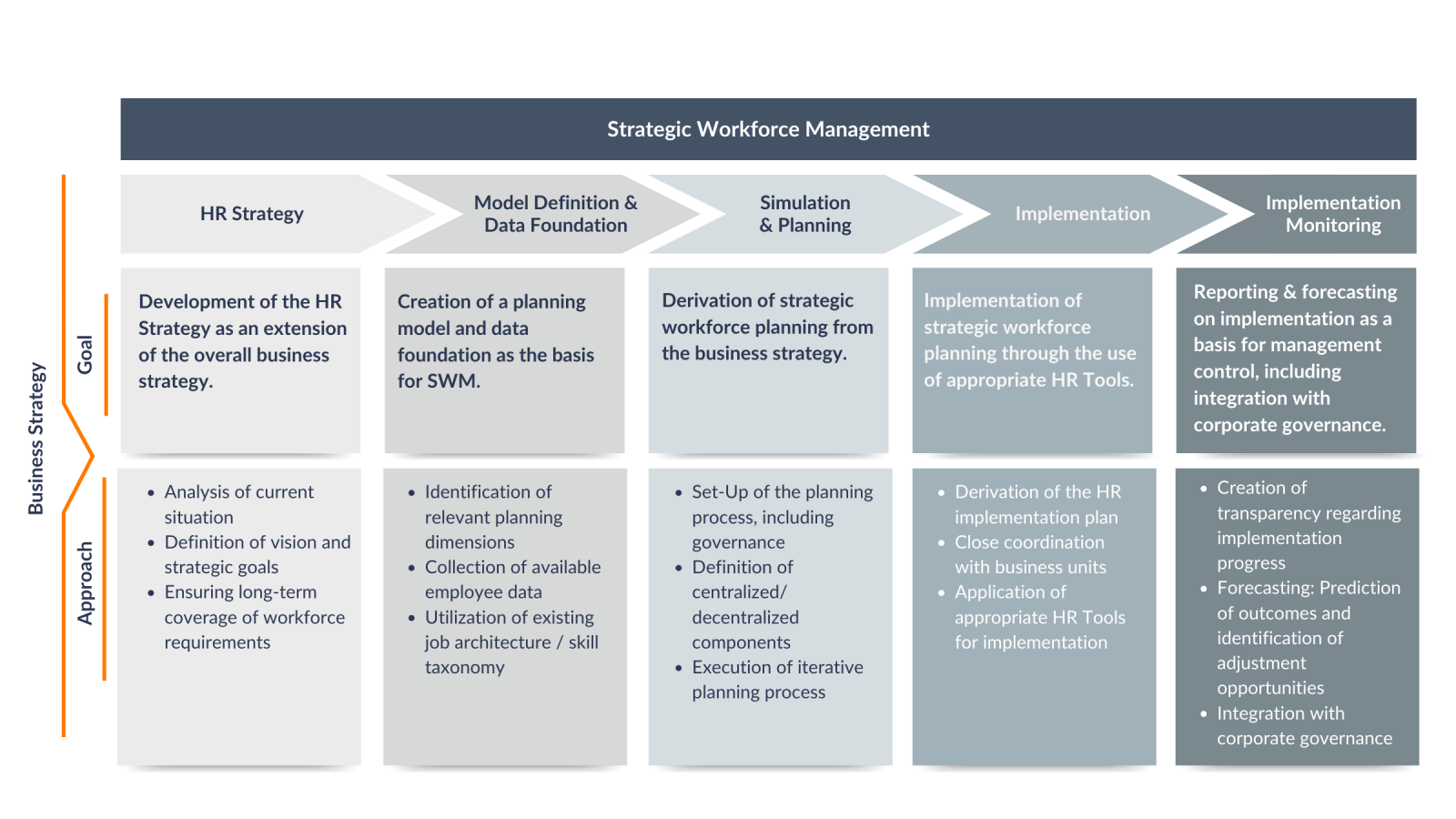Start Your Expedition
The key to success: How Strategic Workforce Management supports your business objectives
The importance of Strategic Workforce Management (SWM) is rapidly increasing in companies. This is due to SWM's ability to secure required resources for the business operations over a defined time horizon, taking the business development into account. Strategic Workforce Management combines the demands of strategic business objectives with a forward-looking resource planning. This enables companies to anticipate the skills their workforce will need, even in dynamic environments.
The holistic approach - from the business strategy, derived HR strategy, and strategic workforce planning to its implementation and subsequent monitoring - enables organizations to make right workforce decisions. Companies are not only gaining the capability to know their current available employee skills, but also to identify the skills they will require in the future to achieve their business objectives.
The value of Strategic Workforce Management for organizations
Strategic Workforce Management (SWM) helps to ensure that the right number of people with fitting skills are available at the required time and place. It supports substantiated workforce decisions and serves as an integral part of financial planning. Demographic changes and the skills shortage significantly impact organizations. SWM accounts for these external influences to support businesses in achieving their long-term objectives.
Organizations should proactively address critical questions: What skills do we currently possess? What skill composition will we need to operate successfully in five years' time? How many employees will we need to meet our business goals? Where and how will we deploy our workforce?
Although the importance of SWM is widely recognized, many organizations face various challenges in its implementation, which often complicate the introduction of SWM. We therefore recommend working along the following the phased model.
Phase Model
Are you facing the challenge of establishing Strategic Workforce Management in your organization?
Organizations often struggle to identify the right starting point for such an initiative. The phased model outlined below provides guidance for taking the first effective steps.

HR Strategy & Model Definition
An organization's business strategy is the starting point, from which a corresponding HR strategy is derived. Once the HR strategy is established, the next phase involves the definition of the planning model as well as the securing of a solid data basis. In this phase, an analysis ensures that the organization's professional, technical, and cultural prerequisites are considered. These prerequisites must be integrated into the phase of model definition and data foundation to successfully implementation of SWM model and its associated planning process.
Read More …Additional examples of functional, technical, and cultural requirements are:
- Definition of the planning model (e.g., scope of internal/external employees)
- Definition of the planning approach (e.g., driver-based planning)
- Establishment of required structures and functional framework (e.g., job architecture)
- Definition of governance and planning process methodology
- Ensuring global availability of necessary data with up-to-date accuracy and quality
- Definition of data ownership for required personnel and financial data
- Definition of required data integration (interfaces)
- Implementation of the functional concept in a planning system software
- Analysis of the current understanding and importance of SWM within the organization
- Establishment of an effective change management approach
- Preparation and execution of communication and training initiatives

Model Definition and Data Foundation
Key focus of the Model Definition & Data Foundation phase is the establishment of the planning model. The starting point is a well-established HR strategy aligned with the personnel requirements of the business units. To define the planning model, the relevant planning dimensions for the organization must be determined. These dimensions shall address the key questions of strategic workforce planning. For instance, if a company aims to plan the capacity and costs for its current and future roles, the planning dimensions must reflect these needs (e.g., Roles, FTE/HC, and Costs). The dimensions of Time and Location set the framework for the planning model. These dimensions are used to define in one hand the time horizon for strategic HR planning and in the other hand the organizational (profit center) structure, e.g. regions, business units, legal units and locations.
Simulation and Planning
The Simulation and Planning phase focuses on the preparation and execution of the strategic planning process. In this phase, it is crucial for organizations to define the process governance, the method of process execution (centralized/decentralized), as well as its required roles and responsibilities. Who is authorized to plan workforce capacities and costs for specific business units or legal entities? How will planners and other involved parties collaborate within the process? Addressing these important questions helps organizations define a planning approach that ideally integrates seamlessly into broader enterprise-wide planning processes.
Implementation & Implementation Monitoring
Following the successful completion of strategic workforce planning, the phases of implementation and implementation monitoring take place. A core element of a successful workforce plan implementation is the derivation and application of appropriate HR measures such as recruiting, succession planning, personnel development, training and enablement programs. Through close collaboration between HR and business units, HR instruments can be tailored to align with the strategic workforce plan and individual business needs. Implementation controlling ensures that required personnel capacities and skills are provided through appropriate HR measures in line with the approved workforce plan. Good implementation controlling helps companies to make implementation progress transparent and to quickly identify and react to deviations from the plan.
Our Approach
Our approach of Strategic Workforce Management follows a clear and structured process: From the analysis of your current situation and the development of an individual HR strategy to targeted implementation and continuous optimization - all tailored to your business objectives and future requirements Every step is aligned with your business objectives and future requirements.
1. Inventory
We prioritize a tailored approach for each of our clients, starting with an assessment and comprehensive analysis of your current HR strategy and workforce needs.
2. HR Strategy
Next, we work with you to develop a customized HR strategy that addresses your unique needs and supports your overarching business objectives.
3. Strategic Workforce Planning
In the following step, we create a tailored planning model that serves as the foundation for your strategic workforce planning. Using best practices, we optimize your workforce management.
4. Implementation and Monitoring
We assist our clients in implementing their strategic workforce plans. Continuous monitoring through implementation control and timely adjustments to the strategy ensure long-term success.
Do you have any questions or would you like to find out more about our services?
Contact us for a non-binding consultation.
Why 4C?
As an experienced management consultancy, we understand the challenges and opportunities in today's dynamic world of work. Our approach, combined with deep expertise, pragmatic methods, and cutting-edge technology, makes us the ideal partner to help you achieve your Strategic Workforce Management goals. Contact us to shape the future of your organization together.
Contact Us
Please note that this website provides only a limited glimpse into our services. Our expertise and range of offerings cannot be fully captured on this platform. For personalized advice and to address your specific needs effectively, we warmly invite you to get in touch with us. Together, we can develop tailored solutions to meet your requirements.
Thank you for your trust. We look forward to hearing from you.








